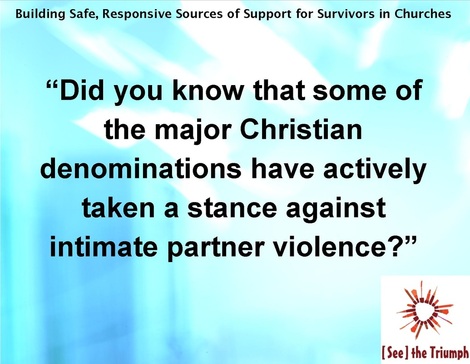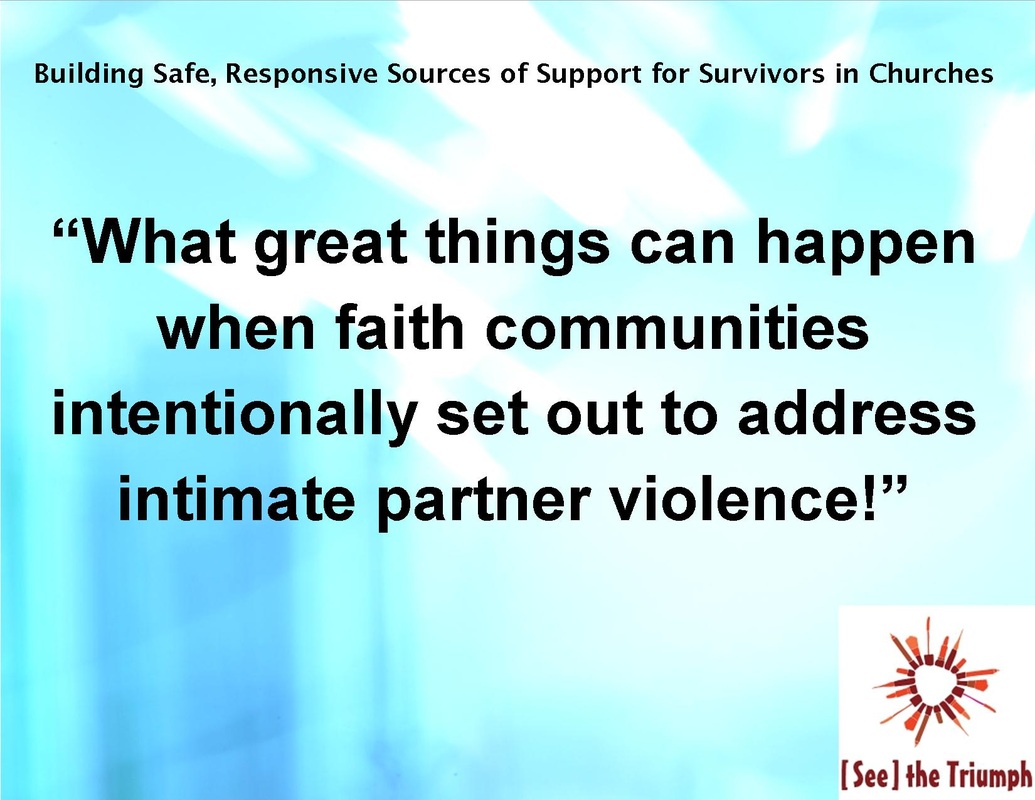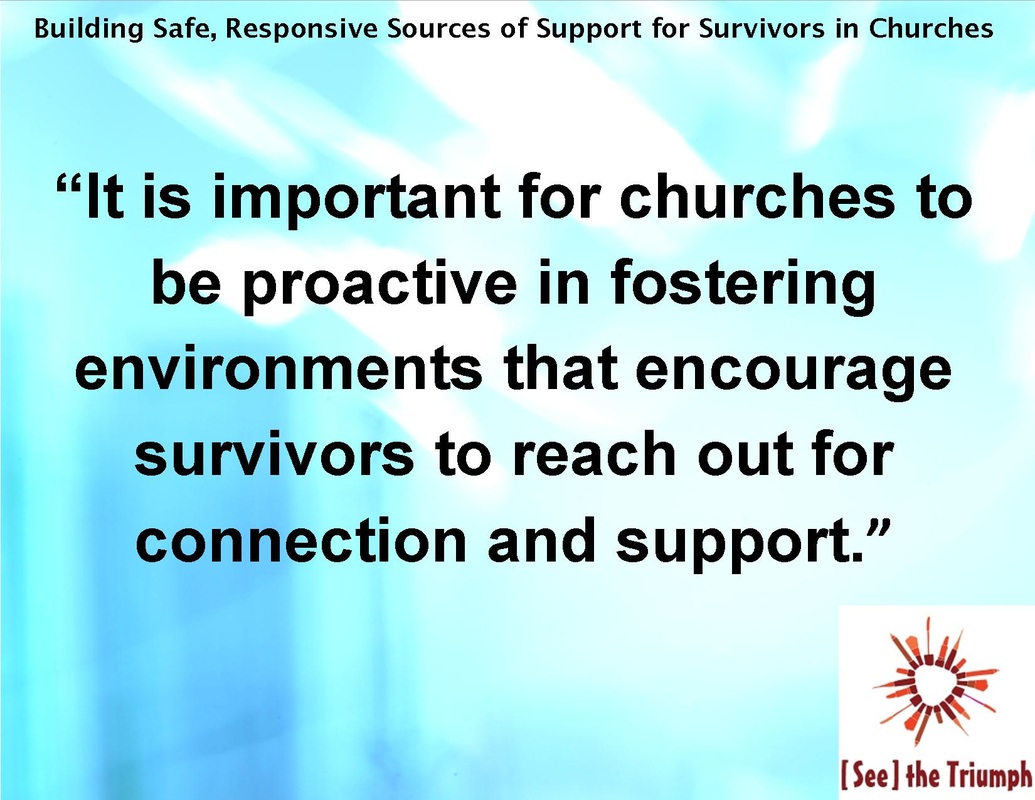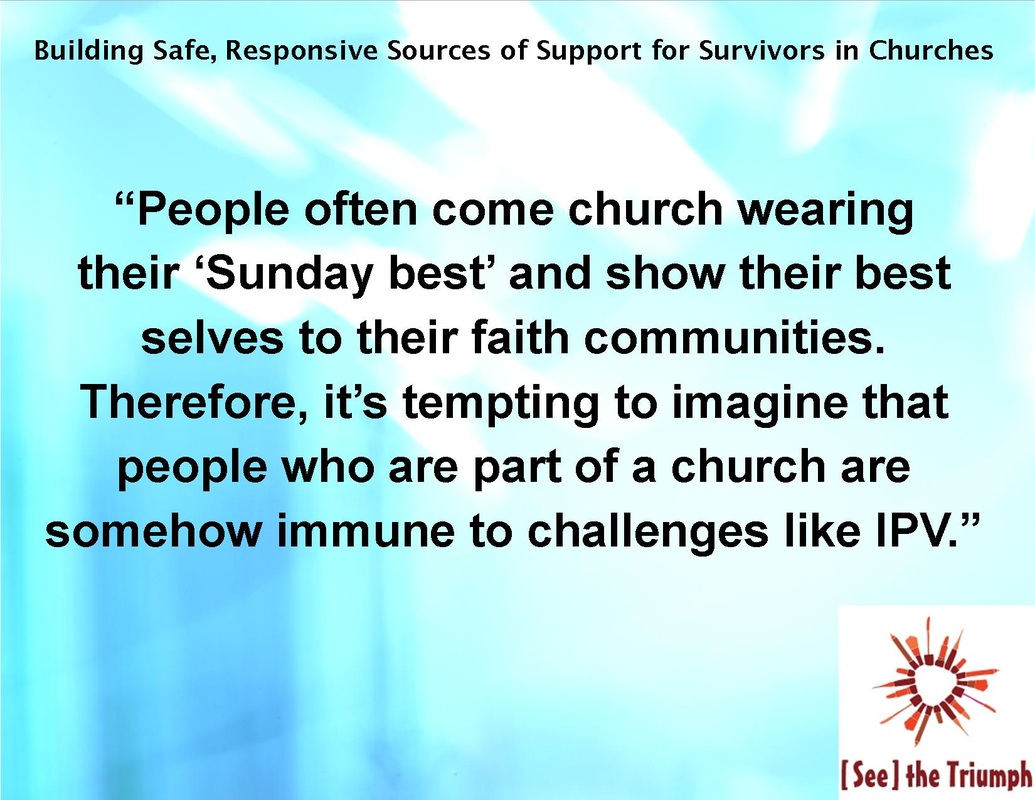|
By Christine Murray, See the Triumph Co-Founder
Last week, we highlighted specific churches and regional religious groups that are creatively and intentionally addressing intimate partner violence. Did you know that some of the major Christian denominations have also actively taken a stance against intimate partner violence (IPV)? The following examples demonstrate that major religious groups often make efforts to support members who have been abused, to promote dialogue and raise awareness about IPV within their memberships and the wider community, and to hold perpetrators accountable for their violent behaviors. Check out the links below for more information about each denomination’s stance and/or initiatives:
I believe that these denominational stances are really important and meaningful in the movement to end IPV and the stigma around it. They create a foundation on which local church leaders can take action to support survivors and engage in prevention initiatives. In addition, these organizational messages send a clear message to survivors that the abuse they’ve experienced is not condoned by their church. I commend all of these religious leaders’ efforts, which go a long way in challenging the stigma surrounding IPV. By Christine Murray, See the Triumph Co-Founder
As we got ready for this month’s focus on how churches can play an important role in challenging the stigma surrounding intimate partner violence, we saw a lot of great examples of churches doing really amazing work to address intimate partner violence (IPV), both within their congregations and in their wider communities. So, today, I wanted to share some of those examples with you, because I think those examples offer a starting point for people who may be considering actions they can take within their own faith communities. Check out some of these great ways that churches are taking on the issue of IPV. You can click on the links to learn more about each initiative.
We hope learning about these examples inspires more creative, effective ideas about how churches can rally together to support survivors and prevent further abuse. We know that there are many other examples out there, too, and we hope you’ll share those with us and other members of the See the Triumph community. By Christine Murray, See the Triumph Co-Founder
Many people view their faith communities as a major source of social support and connection in their lives. For many, a faith community can even come to feel like a second family, which shows just how deeply valued these connections can be for people of faith. On the positive side, the strength of these social connections offers a potentially valuable source of support for survivors, including those currently experiencing abusive relationships. This support can be practical (e.g., providing transportation or housing), emotional (e.g., providing validation when telling one’s story), moral (e.g., coming to court hearings to support a survivor), and spiritual (e.g., prayer and spiritual encouragement). Unfortunately, however, some of the survivors in our research faced isolation, separation, and loss of status within their church communities after others found out about the abuse they experienced. Consider, for example, the following quotes:
It’s important to note that faith communities often have sub-groups and different social networks within the larger congregation. Therefore, it is possible that survivors of intimate partner violence may find that some segments of their communities are more or less isolating than others. It certainly is possible that the survivors quoted above encountered smaller segments of a population that did not represent the beliefs of the larger group or the leadership of the faith communities. However, social isolation is an important issue for leaders and members of congregations who want to ensure that their faith communities are welcoming and supportive to survivors of abuse. It is important to consider how every level of faith communities can offer a consistently supportive environment to members and others who seek help for abuse. Faith communities offer a potentially valuable source of social support and connection for survivors of intimate partner violence. However, survivors may feel isolated and unwelcome if they encounter stigmatizing reactions within their faith communities. Therefore, it is important for churches to be proactive in fostering environments that encourage survivors to reach out for connection and support. By Christine Murray, See the Triumph Co-Founder
Throughout March, we at See the Triumph are turning our attention to the stigma that survivors of intimate partner violence (IPV) may face within their faith communities, and especially within churches. In our next several posts in this series, we’ll share some of the ways we heard this stigma happens through our research. To set the stage for this month, I wanted to apply the five steps to challenging the stigma surrounding intimate partner violence within communities that we outlined in January to provide some specific examples of what this may look like within the context of faith communities. The five steps we put forth were as follows, with examples of how they may be applied within churches: Step 1: Acknowledge the problem. People often come church wearing their “Sunday best” and show their best selves to their faith communities. Therefore, it’s tempting to imagine that people who are part of a church are somehow immune to challenges like IPV. It is especially shocking when cases comes to light in which someone in a leadership position within a church (e.g., a pastor or elder) has been violent toward an intimate partner. (See this news story, for example.) Many people believe that religious people--and especially leaders--travel a higher moral road than others. As such, acknowledging that IPV can occur among people in faith communities can be a major challenge. But, this recognition is important because without acknowledging that members of a religious group can experience IPV, it can be difficult to address the issue in a meaningful way. Step 2: Educate yourself. Beyond acknowledging that IPV can occur within faith communities, one of the first steps that church leaders and members can take toward supporting survivors and challenging the stigma surrounding IPV is to offer educational opportunities for members and leaders alike. These may take the form of bringing in speakers (e.g., professionals and/or survivors), attending conferences and trainings, and distributing educational handouts and flyers about the dynamics of IPV to members. Step 3: Initiate conversations. I think that churches are in a unique position to open really meaningful dialogues about IPV. For many people, a church is not just somewhere to worship once a week, but a source of social interaction, a sense of community, and often even a “second family.” Therefore, many people have the potential for close and supportive relationships within their churches, so there is are opportunities for in-depth conversations that can happen at different levels. Beyond one-on-one conversations with friends within the church, people can have conversations in small groups, Sunday school classes, youth groups, prayer groups, and even church-wide meetings. I’ve had the opportunity to speak about IPV with church groups before, and I’ve found them to be really lively, compassionate conversations, often ending with the sincere question of: “What can we do to help?” Therefore, I‘ve seen firsthand the value of having these conversations, in that they often provide the motivation for church members to take action. Step 4: Offer resources. I believe that churches can play a key role in helping to connect people who are experiencing abuse with the services and resources that they need to seek safety. Some people will seek help from their church before they would ever think to reach out to a community agency, such as a domestic violence shelter. Therefore, the messages they hear from the people in their church when they reach out for help can make a big difference in whether they reach out for more help or not. I think it’s critical that church leaders, and ideally all members, understand how to access services for IPV in their local community. Identifying the relevant agencies and how to get in touch with them (e.g., through a crisis line) can help ensure that this information is available whenever a need arises. Churches also can consider if and how they can offer other types of resources for people experiencing IPV. These resources may include food and clothing (and possibly even a safe place to stay) after a survivor leaves an abusive relationship, child care and transportation, and links to other relevant community services (e.g., for counseling or medical care). Many church leaders are well-connected in their local communities and therefore well-poised to help survivors access the support they need in the community. Churches also can provide resources for survivors who don’t yet feel comfortable openly seeking help for IPV. One possible way to do this would be to hang posters with domestic violence crisis line numbers (e.g., the National Domestic Violence Hotline) in public (e.g., hallways and classrooms) and private (e.g., bathroom stalls) around the church. Another approach would be to include information about IPV on the church web-site or posting relevant information on social media sites. Step 5: Uproot the causes of stigma. Later this month, we’ll share a blog post that will explore this issue more in-depth, but as a preview, one of the points we heard from some of the survivors in our studies was that religious beliefs and/or practices have the potential to be used to perpetuate abuse. I know this is a really difficult issue to address, because religious beliefs are often very closely-held, as they are for me personally. And yet, I think it’s really important to consider if certain belief systems may promote abuse, or at least make it less unacceptable. And so, I ask you to consider: Are there any teachings or practices within your own faith community that may hide, justify, or perpetuate abuse? Breaking the silence around IPV within churches is another critical way that the stigma can be uprooted. Silence makes it easier to ignore or minimize the problem, or to deny that it is possible within one’s faith community. Therefore, by making IPV a visible issue and taking clear stance that relationships should be safe, healthy, and supportive, churches can take major strides toward uprooting the stigma surrounding this issue. Throughout the coming month, we hope you’ll share your ideas and suggestions for how to challenge the stigma around IPV in churches. And, if you are part of a church community, we encourage you share the relevant resources with leaders in your community to get a conversation going about what your own faith community can do to address this important issue! |
Archives
April 2024
CategoriesAll About Intimate Partner Violence About Intimate Partner Violence Advocacy Ambassadors Children Churches College Campuses Cultural Issues Domestic Violence Awareness Month Financial Recovery How To Help A Friend Human Rights Human-rights Immigrants International Media Overcoming Past Abuse Overcoming-past-abuse Parenting Prevention Resources For Survivors Safe Relationships Following Abuse Schools Selfcare Self-care Sexual Assault Sexuality Social Justice Social-justice Stigma Supporting Survivors Survivor Quotes Survivor-quotes Survivor Stories Teen Dating Violence Trafficking Transformative-approaches |
Search by typing & pressing enter






 RSS Feed
RSS Feed